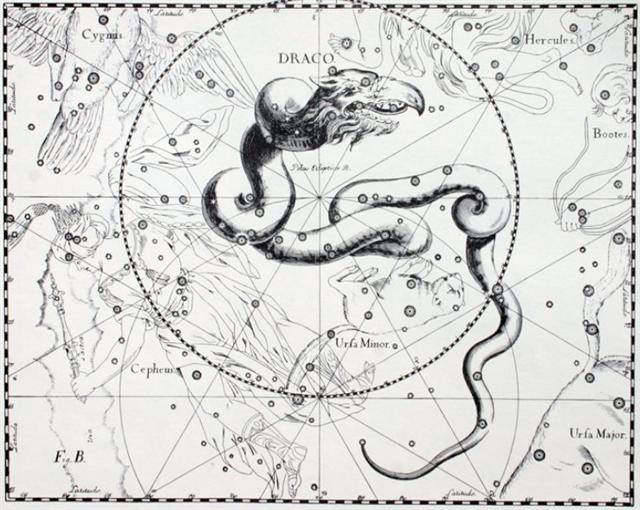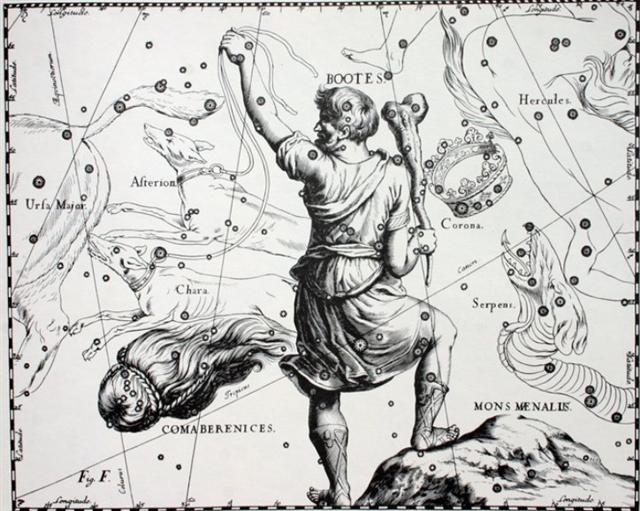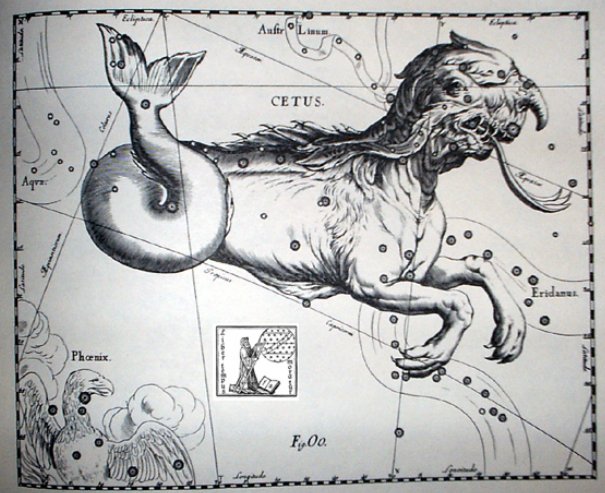When king Hotu worried about the fate of his ancient parent
king
Oto Uta
it could be because Thuban at the top of the
World Tree,

with
Hamal at the spring equinox, had been abandoned in favour of Polaris
at the top with the First Point of Aries at the
equinox:

| te
rima |
E
tupu |
ki
roto |
o
te hau tea |
ki
te henua - te maro |
rutua - te pahu |
 |
 |
 |
 |
 |
 |
|
*Ca14-29 (32 + 360) |
Cb1-1 (393) |
Cb1-2 |
Cb1-3 |
Cb1-4
(396) |
Cb1-5 |
|
CLOSE TO THE SUN: |
|
April 16 (471 = 364 + 107)
ANA-NIA-10 (Pillar-to-fish by)
χ
Ceti (26.1),
POLARIS =
α
Ursae Minoris,
BATEN KAITOS
(Belly of the Fish) =
ζ
Ceti
(26.6),
METALLAH (Triagle) = α Trianguli
(26.9) |
17 (91 + 16)
Al Sharatain-1 /
Ashvini-1 /
Bond-16 (Dog) /
Mahrū-sha-rishu-ku-1 (Front of the
Head of Ku)
SEGIN = ε Cassiopeia,
MESARTHIM = γ
Arietis,
ψ
Phoenicis (27.2),
SHERATAN
(Pair of Signs) =
β
Arietis,
φ
Phoenicis (27.4)
*351.0 = *27.4 - *41.4 |
18
ι Arietis (28.0), λ Arietis (28.2),
υ Ceti (28.8) |
19
ALRISHA (The Knot) =
α Piscium,
χ Phoenicis (29.2), ε Trianguli
(29.4),
ALAMAK (Caracal) = γ Andromedae
(29.7)
*353.0 = *29.4 - *41.4 |
20
Arku-sha-rishu-ku-2 (Back of the
Head of Ku)
2h (30.4)
κ
Arietis (30.3),
HAMAL
(Sheep) =
α
Arietis
(30.5)
ALKES (α
Crateris) |
21 (111)
DELTOTUM = β
Trianguli
(31.2), ι Trianguli (31.7), η
Arietis (31.9)
*355.0 = *31 - *41 |

The
front of the head of Ku
(Cetus) - alias the Hawaiian war god
Kū - will be at the
back side if we change the framework
of the whole to let time increase from right to
left (as in the writings of the
Arabs). In both views, however, the
development is upwards:

...
Breadfruit (Artocarpus
altilis) is a tree and fruit
native to the Malay Peninsula and
western Pacific islands. It has also
been widely planted in tropical
regions elsewhere. It was collected
and distributed by Lieutenant
William Bligh as one of the
botanical samples collected by HMS
Bounty in the late 18th
century, on a quest for cheap,
high-energy food sources for British
slaves in the West Indies ...
According to an etiological Hawaiian
myth, the breadfruit originated from
the sacrifice of the war god Kū.
After deciding to live secretly
among mortals as a farmer, Ku
married and had children. He and his
family lived happily until a famine
seized their island. When he could
no longer bear to watch his children
suffer, Ku told his wife that
he could deliver them from
starvation, but to do so he would
have to leave them. Reluctantly, she
agreed, and at her word, Ku
descended into the ground right
where he had stood until only the
top of his head was visible. His
family waited around the spot he had
last been day and night, watering it
with their tears until suddenly a
small green shoot appeared where
Ku had stood. Quickly, the shoot
grew into a tall and leafy tree that
was laden with heavy breadfruits
that Ku's family and
neighbors gratefully ate, joyfully
saved from starvation ... |
|
20 (471 - 27 = 444) |
21 (80 = 107 - 27) |
22 |
23 (2 * 41) |
'March
24 |
Julian equinox |
|
CLOSE TO THE FULL MOON: |
|
no star listed (209) |
MUPHRID (Solitary Star) = η Bootis
(210.1), ζ Centauri (210.3) |
φ Centauri (211.0), υ¹ Centauri
(211.1), υ² Centauri (211.8), τ
Virginis (211.9) |
AGENA (At the Knee) =
β
Centauri
(212.1),
θ
Apodis (212.5),
THUBAN
(Dragon) =
α
Draconis
(212.8) |
14h (213.1)
π
Hydrae,
χ
Centauri (213.0),
MENKENT (Shoulder of the Centaur) =
θ
Centauri
(213.1) |
Neck-2 (Dragon)
ASELLUS TERTIUS (3rd Ass Colt) =
κ
Bootis,
κ
Virginis,
14 Bootis
(214.8) |
 |
|
rutua te
maeva |
|
Maeva. T. 1. Move.
Rangi-maeva = Moving Sky
(name of a marae). 2. Greet,
greeting. Henry. |
 |
|
Cb1-6 (398) |
|
ξ¹ Ceti
(32.1) |
|
Al Ghafr-13 (The Cover) /
Svāti-15 (Very Good) /
TAHUA-TAATA-METUA-TE-TUPU-MAVAE-6
(a pillar to stand by)
15 Bootis
(215.2),
ARCTURUS
=
α
Bootis
(215.4),
ASELLUS SECUNDUS (2nd Ass Colt)
=
ι
Bootis
(215.5),
SYRMA
(Train of the Virgin's Robe) =
ι
Virginis,
λ
Bootis (215.6),
η
Apodis (215.8)
*174.0 = *215.4 - *41.4 |

I.e., due to how the fixed sky had apparently
moved (rangi maeva) the
northern spring equinox date had shifted to a place
5
days earlier. The proper Roman equinox date
was now to be counted as number 79 ('March 20 → *320 →
Dramasa = the South Pole star),
... Ecclesiastically, the equinox is
reckoned to be on 21 March (even though
the equinox occurs, astronomically
speaking, on 20 March in most years) ...
instead of
number 84 ('March 25) → 320 - 8 * 29½. These
ancient Roman time-frame
dates corresponded to the current
Gregorian April 16 (106 +
365 = 471) respectively to April 21 (111
+ 365 = 476).
The Neck at
κ Virginis determined the position of the Full
Moon in April 21 (79 + 32 = 111).
476 (April 21) - 41 (→ Bharani) = 435
("March 11) = 294 (September 21) +
(100 + 41):
|
GREGORIAN |
40 |
BHARANI |
|
April 21 (111) |
"March 11 (70 = 111 -
41) |
|
365 + 111 = 476 |
365 + 70 = 435 |
|
Sept 21 (294) |
"Sept 10 (253 = 294 -
41) |
|
111 + 183 = 294 |
70 + 183 = 253 |
|
he
ki a Hotu.ku kori ana tau ngaio
era i te ariki |
Hotu spoke, 'These fellows have
done a mean thing [ku
kori ana tau ngaio era]
to King Oto Uta!" |
|
i a
oto uta. |
|
i
hati era te
ngao.o
te ariki o oto uta.he ōho.atu |
After the neck of Oto Uta had
been broken, Kuihi and Kuaha
arrived. They picked up the neck
of King Oto Uta, took it, and
brought it with them. |
|
a
kuihi.a kuaha.he too mai i te
ngao.o te a(-) |
|
riki o oto uta.he mau he ōho.mai
he tuu ki |
|
Gao. 1. Neck. 2. Glans
penis (te gao o te kohio),
neck of penis. Vanaga. Neck,
throat, (naho G); gao
pukupuku, scrofula; hore
te gao, to cut the head off;
arakea gao, scrofula.
Gaogao, calm. Gaoku,
to eat greedily. Gaopu,
to choke on a bone. Churchill. |
|
mua
ki te hanga.ki hanga rau.i haka
rere ai |
They arrived out in the bay [he
tuu ki mua ki te hanga],
in Hanga Rau. (There) Kuihi and
Kuaha left (the fragment). |
|
e
kuihi.e kuaha. |
We should notice that ngao is the
same as ngaro with the exception
of the loss of a single, though
important, letter:
|
Sumerian SAG |
 |
Phoenician resh |
 |
Greek rho |
Ρ
(ρ) |
|
... Resh
(Arabic: rāۥ)
is the twentieth letter of many
Semitic alphabets, including
Phoenician, Aramaic, Hebrew ...
The word resh is usually
assumed to have come from a
pictogram of a head, ultimately
reflecting Proto-Semitic *raۥ(i)š-.
The word's East Semitic cognate,
rēš-, was one possible
phonetic reading of the Sumerian
cuneiform sign for 'head' (SAG).

.jpg)
... Then I
become aware of ... a presence -
a faint, ghostly glimmering,
like moonglow, that has appeared
on the solstice stone. I don't
know how long it lasts, a second
or two only I would guess, but
while it is there it seems less
like a projection - which I know
it to be - than something
immanent within the stone
itself. And it seems to function
as a herald for it fades almost
as soon as it has appeared and
in its place the full effect
snaps on - instantaneously. It
wasn't there, and then it's
there. As Chris had described,
the effect does curiously
resemble a poleaxe, or a flag on
a pole, and consists of a
'shaft', narrow at the base but
widening a little towards the
top, running up the left hand
side of the solstice stone,
surmounted by a right-facing
'head' or 'flag'. An instant
later an almond-shaped spot of
light, like an eye, appears a
few centimeters to the right of
the 'flag' and the effect is
complete. Weirdly - I do not
claim it has any significance -
this flag-on-a-pole symbol is
the ancient Egyptian hieroglyph
neter, meaning 'god', or
'a god' - and not to be
understood at all in the
Judaeo-Christian usage of that
word but rather as a reference
to one of the supernatural
powers or principles that guide
and balance the universe.
Manifested here, in this strange
Stone Age temple, it glows, as
though lit by inner fire
...

Marija Gimbutas: 'To sleep
within the Goddess's womb was to
die and to come to life anew'.
In a system of reincarnation the
old one must die in order to be
reborn, of course. At midsummer
Sun comes to a standstill, and
this must therefore be an
occasion when the 'flame of
life' had to be transported into
a new body. |
... The four bereaved and searching
divinities, the two mothers and their
two sons, were joined by a fifth, the
moon-god Thoth (who appears sometimes in
the form of an ibis-headed scribe, at
other times in the form of a baboon),
and together they found all of Osiris
save his genital member, which had been
swallowed by a fish ...

... Then the big Fish
did swallow him, and he had done acts
worthy of blame.
Had it not been that he (repented and)
glorified Allah, He would certainly have
remained inside the Fish till the Day of
Resurrection. - Qur'an, chapter 37
(As-Saaffat), verse 139–144.
But We cast him forth
on the naked shore in a state of
sickness,
And We caused to grow, over him, a
spreading plant of the gourd kind.
And We sent him (on a
mission) to a hundred thousand (men) or
more.
And they believed; so We permitted them
to enjoy (their life) for a while. -
Qur'an, chapter 37 (As-Saaffat), verse
145–148 ...

|
Egyptian sticks |
 |
Phoenician
taw |
 |
Greek chi |
Χ (χ) |
|
Greek tau |
Τ (τ) |
|
In Plato's
Timaeus, it is
explained that the two bands
that form the soul of the
world cross each other like
the letter Χ.

Roman XII = 12 → XIII = 13,
with the Nose in between -
and later, after the Mouth,
the cycle would begin anew
(I).
Chi or X is
often used to abbreviate the
name Christ, as in the
holiday Christmas (Xmas).
When fused within a single
typespace with the Greek
letter Rho, it is called the
labarum and used to
represent the person of
Jesus Christ. (Wikipedia)

... tau
is the 19th letter of the
Greek alphabet. In the
system of Greek numerals it
has a value of 300 ...
Taw is believed to be
derived from the Egyptian
hieroglyph meaning 'mark'
...
Taw,
Tav or Taf is
the twenty-second and last
letter in many Semitic
abjads ... In gematria
Tav represents the
number 400, the largest
single number that can be
represented without using
the Sophit forms ...
'From
Aleph to Taf'
describes something from
beginning to end; the Hebrew
equivalent of the English
'From A to Z' ...
Tav
is the last letter of the
Hebrew word emet,
which means truth. The
midrash explains that
emet is made up of the
first, middle, and last
letters of the Hebrew
alphabet (Aleph,
Mem, and Tav...).
Sheqer (falsehood),
on the other hand, is made
up of the 19th, 20th, and
21st (and penultimate)
letters.
Thus, truth
is all-encompassing, while
falsehood is narrow and
deceiving. In Jewish
mythology it was the word
emet that was carved
into the head of the
Golem which ultimately
gave it life. But when the
letter 'aleph' was erased
from the Golem's
forehead, what was left was
'met' - dead. And so
the Golem died ...
(Wikipedia)
 |
|









.jpg)





